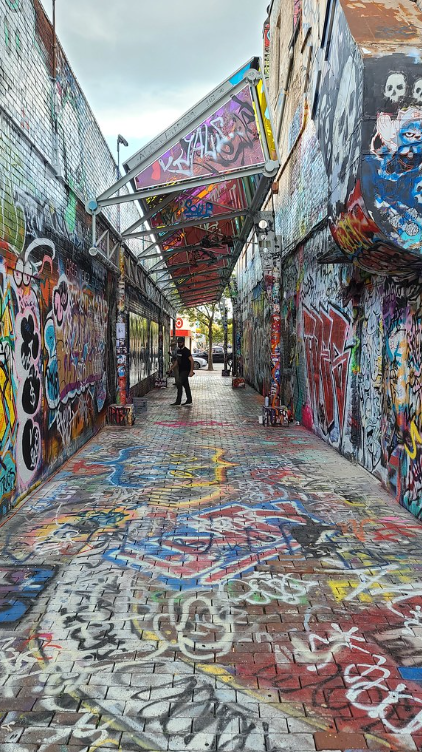This past February 25th, a number of students and I gathered virtually to watch local filmmaker Weiying Olivia Huang’s new documentary, “City as Canvas: Above the Free Walls.” This engaging film introduces viewers to the legal graffiti alley in Cambridge’s Central Square neighborhood, and a number of the artists who regularly paint there. The narrow bricked passage between businesses is formally named Richard B. “Rico” Modica Way, but commonly referred to as Graffiti Alley.
One of very few legal graffiti walls in the entire state of Massachusetts, Olivia became interested in the artworks and artists working here and soon began to plan for a documentary film. She received initial support from the Cambridge Arts Council to pursue the project, then, once filming and editing was completed, she received an ‘Expand Massachusetts Stories’ grant from Mass Humanities in 2021 to provide for a schedule of screenings and artist workshops in the community. I served as Humanities Advisor for the grant, and brought the film to the attention of our Simmons Panopticon student group. Panopticon is comprised of graduate students in the library and information science program at Simmons who are interested in art and art librarianship. I also serve as the faculty liaison for the group, whose interests align with my own teaching and research in graffiti and street art documentation, art documentation, and information organization.

We gathered that night to watch the film, which runs just over an hour, and then discussed it with Olivia, who answered questions about filming and the featured artists. What is evident from the story she tells about Modica Way and the artists who take advantage of a stress-free spot to create public art, is that there is a very positive response to the entire endeavor. There are occasional naysayers, one even shown in the film, but the artists are overwhelmingly pleased with both the opportunity to practice their art for all to see and the rest of us to be able to enjoy it. The walls change often, even daily, and Olivia knows of at least a couple locals who have been photographing the alley regularly for years, documenting the changes. Anyone can paint, not just those who call themselves graffiti or street artists, but regulars from around the globe have been known to stop by and paint when in the Boston area. Legal walls can be a fantastic artistic outlet, and provide joy for many.
Researching graffiti art documentation around the world, there is a mixed reaction to the works, especially when done on private property, though acceptance of the art form has taken hold in recent years. Especially significant has been the recent public art response to local and global crises, such as the murder of George Floyd in Minneapolis, the Covid-19 pandemic, and the almost daily news of yet another tragic mass shooting in the US.
Writers, as graffiti artists are sometimes called, have been noticed and their works documented online in various venues such as Flickr and Instagram, and on a multitude of websites designed specifically to feature a record of their works. This ad hoc, global community documentation of a sorts serves to preserve often all too fleeting artworks, sometimes painted over or buffed out within hours of their creation. The film discusses the need to make art, the mutual benefits provided to artists, businesses, individuals and communities, and the desire for more legal walls such as Modica Way, where graffiti artists and other public or street artists can paint without the fear of incarceration and also without damaging private property.
Olivia’s goal is to continue screenings after the grant period, and to further the documentary’s reach by securing a slot to air it on local Boston PBS affiliate WGBH-TV. View the film trailer of “City As Canvas” on YouTube at https://youtu.be/4T4PTH62RD0.


 I am a PhD dissertator at the University of Wisconsin – Milwaukee in the School of Information Studies (SOIS). My research is in the area of knowledge organization (KO). I am studying how people gather, organize, share, and describe collections using various systems for organization, such as classifications, taxonomies, folksonomies, and metadata schemas. Their collections may consist of research articles, books, artworks, or even abstract things such as concepts or ideas.
I am a PhD dissertator at the University of Wisconsin – Milwaukee in the School of Information Studies (SOIS). My research is in the area of knowledge organization (KO). I am studying how people gather, organize, share, and describe collections using various systems for organization, such as classifications, taxonomies, folksonomies, and metadata schemas. Their collections may consist of research articles, books, artworks, or even abstract things such as concepts or ideas.